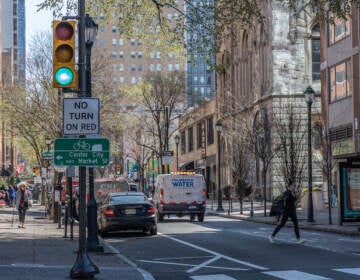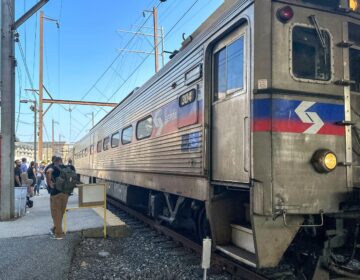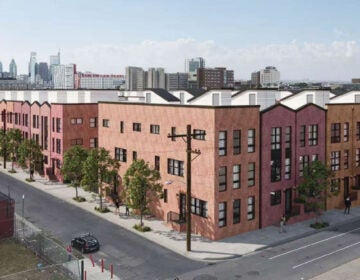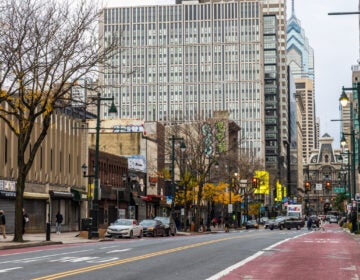Philly’s commuter foot traffic outpaced most peer cities’ downtowns in 2024
The majority of workers who commute into the urban core have returned since the COVID-19 pandemic began five years ago, according to the annual State of Center City report.
Listen 0:50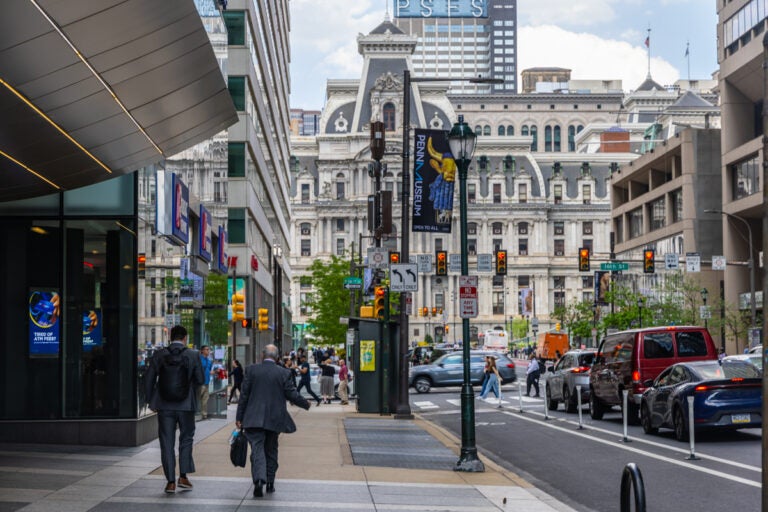
The heart of Philadelphia commerce in Center City. (Kimberly Paynter/WHYY)
Have a question about Philly’s neighborhoods or the systems that shape them? PlanPhilly reporters want to hear from you! Ask us a question or send us a story idea you think we should cover.
Commuter foot traffic into Center City has rebounded to rates higher than downtowns in other cities, according to the annual State of Center City report released Thursday.
The number of nonresident workers commuting into Center City between October and December 2024 was 74% of the number of workers for the same period in 2019, according to anonymized smartphone data collected by Placer.ai and analyzed by Center City District.
Among the 15 major U.S. downtowns, the average commuter recovery rate was 68% last year.
Downtown commuter foot traffic was higher in Philadelphia than in most other cities last year, but not in San Diego or Midtown Manhattan, which had rates of 77% and 83%, respectively.
Placer.ai is a technology company that pings smartphones within a geographical area. Commuters are considered smartphones that regularly visit Center City during the workweek but don’t spend time there overnight. Residents are counted as smartphones that spend the night in Center City.
About 73% of workers in Philadelphia — commuters and downtown residents — are back in person across Center City offices in 2024, up from 69% in 2023, according to the Placer.ai data.
“Maybe a surprise to people is that the rate of office workers coming back is still going up,” said Clint Randall, vice president of economic development for Center City District. “Folks still want to be here in Center City and perhaps more than far-flung suburban office parks because it’s a more dynamic and inviting environment.”
Overall pedestrian foot traffic in Center City, which includes visitors, residents and workers, returned to 90% of pre-pandemic levels in 2024.
That means there were about 378,000 pedestrians each day in 2024. In March, there were 400,000 pedestrians each day on average.
“Which we think is very strong and much of that was driven by our population growth,” said Prema Katari Gupta, president and CEO of Center City District.
Last year, weekend evening crowds in Rittenhouse Square and Midtown Village were 25% larger than in 2019.
About 200,000 people live in greater Center City, which runs along Broad Street between Girard Avenue in North Philly and Tasker Avenue in South Philly.
The number of people who live in Center City increased by 3% between 2023 and 2024, according to the smartphone data. Citywide, the increase was less than 1%.
About 90% of workers who live within two miles of their office have returned to work in person since 2019. That includes city workers who returned to the office five days a week per Mayor Cherelle Parker’s order in June 2024.
But proposed deep cuts to SEPTA services would hamstring commuters across the city.
SEPTA faces a $214 million budget deficit this year, and it’s unclear whether Pennsylvania Senate Republicans will approve more public subsidies for the transit system.
“We’re a little nervous about this transit funding uncertainty,” Katari Gupta said. “We are hopeful that a lot of smart, thoughtful people understand how critical this issue is, not just for Center City, but the entire region.”

Subscribe to PlanPhilly
WHYY is your source for fact-based, in-depth journalism and information. As a nonprofit organization, we rely on financial support from readers like you. Please give today.



